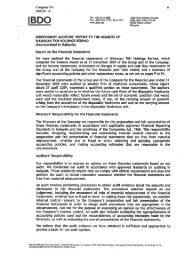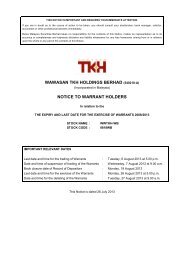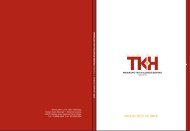Annual Report 2011 (Part I) - Wawasan TKH Holdings Berhad
Annual Report 2011 (Part I) - Wawasan TKH Holdings Berhad
Annual Report 2011 (Part I) - Wawasan TKH Holdings Berhad
Create successful ePaper yourself
Turn your PDF publications into a flip-book with our unique Google optimized e-Paper software.
WAWASAN <strong>TKH</strong> HOLDINGS BERHAD (540218-A) • ANNUAL REPORT <strong>2011</strong><br />
043<br />
NOTES TO THE FINANCIAL STATEMENTS<br />
31 DECEMBER <strong>2011</strong> (cont’d)<br />
4. SIGNIFICANT ACCOUNTING POLICIES (cont’d)<br />
4.6 Investments in subsidiaries<br />
A subsidiary is an entity in which the Group and the Company have power to control the financial and<br />
operating policies so as to obtain benefits from its activities. The existence and effect of potential voting<br />
rights that are currently exercisable or convertible are considered when assessing whether the Group<br />
has such power over another entity.<br />
An investment in subsidiary, which is eliminated on consolidation, is stated in the Company’s separate<br />
financial statements at cost. Investments accounted for at cost shall be accounted for in accordance<br />
with FRS 5 Non-current Assets Held for Sale and Discontinued Operations when they are classified as<br />
held for sale (or included in a disposal group that is classified as held for sale) in accordance with FRS 5.<br />
When control of a subsidiary is lost as a result of a transaction, event or other circumstance, the Group<br />
would derecognise all assets, liabilities and non-controlling interests at their carrying amounts and to<br />
recognise the fair value of the consideration received. Any retained interest in the former subsidiary is<br />
recognised at its fair value at the date control is lost. The resulting difference is recognised as a gain or<br />
loss in profit or loss.<br />
4.7 Intangible assets<br />
(a) Goodwill<br />
Goodwill recognised in a business combination is an asset at the acquisition date and is initially<br />
measured at cost being the excess of the sum of the consideration transferred, the amount of any<br />
non-controlling interest in the acquiree and the fair value of the acquirer’s previously held equity interest<br />
(if any) in the entity over net of the acquisition-date amounts of the identifiable assets acquired<br />
and the liabilities assumed.<br />
If, after reassessment, the Group’s interest in the fair value of the acquiree’s identifiable net assets<br />
exceeds the sum of the consideration transferred, the amount of any non-controlling interest in the<br />
acquiree and the fair value of the acquirer’s previously held equity interest in the acquiree (if any),<br />
the excess is recognised immediately in profit or loss as a bargain purchase gain.<br />
After initial recognition, goodwill is measured at cost less accumulated impairment losses, if any.<br />
Goodwill is not amortised but instead tested for impairment annually or more frequently if events or<br />
changes in circumstances indicate that the carrying amount may be impaired. Gains and losses on<br />
the disposal of an entity include the carrying amount of goodwill relating to the entity sold.<br />
(b) Intangible assets<br />
Intangible assets, other than goodwill, that are acquired by the Group are stated at cost less any<br />
accumulated impairment loss.<br />
Subsequent expenditure on capitalised intangible assets is capitalised only when it increases the<br />
future economic benefits embodied in the specific asset to which it relates. All other expenditures<br />
are expensed as incurred.<br />
Intangible assets with indefinite useful lives are tested for impairment annually and whenever there<br />
is an indication that they may be impaired. Intangible assets with indefinite useful life of the Group<br />
are trademarks.<br />
An intangible asset is derecognised on disposal or when no future economic benefits are expected<br />
from its use. The gain or loss arising from the derecognition determined as the difference between<br />
the net disposal proceeds, if any, and the carrying amount of the asset is recognised in profit or loss<br />
when the asset is derecognised.







